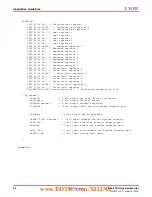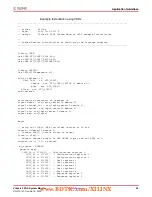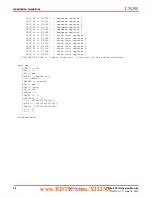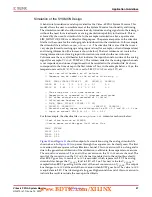
42
Virtex-6 FPGA System Monitor
UG370 (v1.1) June 14, 2010
Analog Inputs
shows the minimum acquisition time for 10-bit accuracy on the external analog
channels.
Equation 4
The auxiliary analog channels (such as, V
AUXP
[15:0], and V
AUXN
[15:0]) have a much larger
R
MUX
resistance that is approximately equal to 30 k
Ω
.
shows acquisition time needed for an auxiliary analog channel (assuming no
external resistance) in unipolar mode.
Equation 5
The –3dB analog bandwidth of these external channels is equal to 880 kHz. The total R
MUX
in unipolar mode is given by 30 k
Ω
+ 30 k
Ω
= 60 k
Ω
.
shows that for differential mode, the acquisition time needed for the auxiliary
analog inputs is 0.69 µs, half that of unipolar mode.
Equation 6
Unipolar Input Signals
When measuring unipolar analog-input signals, System Monitor must be operated in a
unipolar input mode. This mode is selected by writing to configuration register 0. When
unipolar operation is enabled, the differential analog inputs (V
P
– V
N
) have an input range
of 0V to 1.0V. In this mode, the voltage on V
P
(measured with respect to V
N
) must always
be positive.
shows a typical application of unipolar mode. The V
N
input is
typically connected to a local ground or common mode signal. The common mode signal
on V
N
can vary from 0V to +0.5V (measured with respect to ground). Because the
differential input range is from 0V to 1.0V (V
P
to V
N
), the maximum signal on V
P
is 1.5V.
shows the maximum signal levels on V
N
and V
P
in unipolar mode, measured
with respect to analog ground (AV
SS
).
t
ACQ
= 7.62
×
R
MUX
×
C
SAMPLE
t
ACQ
= 7.62
×
60 k
Ω
×
3 pF = 1.37 µs
t
ACQ
= 7.62
×
30 k
Ω
×
3pF = 0.69 µs
X-Ref Target - Figure 19
Figure 19:
Unipolar Analog-Input Range
V
P
, V
N
(V
olt
s
)
0V
0.5V
1.5V
2.5V
1V
2V
Common
Mode R
a
nge
Pe
a
k volt
a
ge on V
P
V
N
(Common Mode)
V
P
V
P
V
N
Common Volt
a
ge
0V to 0.5V
0V to 1V
ADC
UG
3
70_19_060
8
09
www.BDTIC.com/XILINX






























